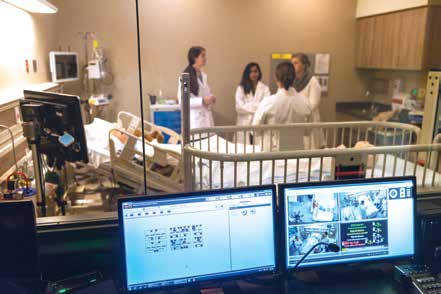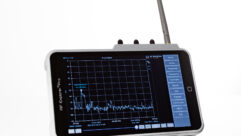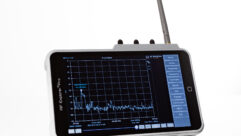

The extent to which an AV system intersects with an IT system on a given project is determined by many things including use case, budget, existing infrastructure, security (or perception of security), time to opening, building architecture and campus design– even interpersonal agendas and communication, among other things.
As with any AV system, design may occur years before opening and involves a balancing act of existing and anticipated technology. There are systems being designed now that are almost completely on the users’ IT network; there are others that orbit in their own digital universe and there are others that are hybrid, whether by design or by evolution.
At the University Of Michigan School Of Nursing, it was the latter, explains Matt LeFeber, CTS, Senior Consultant at The Sextant Group. The extensive AV system was designed on a Crestron DigitalMedia foundation. Late in the design process, the client asked for a way to preview the cameras that support various videoconferencing locations. It was not practical to expand the DM system to support this request, given the number of cameras, LeFeber says. The solution was to equip each camera with an SVSi bridge to the building’s IT network, giving the client preview capabilities from any office. No redesign required.
“The best part about putting things on the network is that by design it is infinitely scalable. That level of flexibility meant we could do something that could have been a real challenge and expense that late in that design.”
The UMich system features 75,000 SF of medical simulation labs, active learning classrooms, small group collaboration spaces and a conference center. The Clinical Learning space includes four debriefing rooms, six simulation labs, four standardized patient suites, one physical assessment lab, one skills lab, and one task training lab.
LeFeber says the Sextant team helped coordinate the demo for competing systems (the school chose EMS SimulationiQ) and helped the client visualize how the simulation system data, images, and related audio would be consumed and distributed by teachers and students, both within the campus and more broadly through videoconferencing.
Sextant Group founder Mark Valenti says this type of holistic collaboration was uniquely applied to UMich, but it’s typical of Sextant’s role as a technology consultant. For different jobs that means different things as the design increasingly encompasses a range of technologies from AV, IT, and other building management technologies. Each market has use case priorities and challenges, many of them driven by the intersection of data, buildings, and work. In medical for example, the Affordable Care Act and the required electronic recordkeeping has greatly increased the role of digital data in those systems.
Any leaning situation—whether medical or otherwise–has to meet the expectations of students who are electronically fluent and who learn visually, often with their own devices. “The network gets very busy, very fast.”
Valenti says he has prioritized multi-disciplinary skills since he founded The Sextant Group in the ‘90s. In 2001, hired Paul Dooley out of the telco and Internet worlds. Dooley’s expertise as a Registered Communications Distribution Designer (RCDD) helped position Sextant at one of the first technology crossroads. (“One of our very first projects was to digitize clinical video in a hospital and deliver it over a asynchronous fiber optic mode to students in another location”).
Dooley remains with the company, and as a CTS-D, an engineer, and a member of Building and Industry Consulting Services International (BICSI), he continues to design and engineer complex infrastructure across varied markets and use cases. His teammates at Sextant, likewise draw on multi-discipline knowledge. Valenti says this ability to be credible in connected and emerging technologies is critical, and the range of expertise required just continues to grow.
“The key is that regardless of the technology you bring a discipline to the design that is driven by math and physics and not just cable from here to there. You know your math, you know your electronics, you know your software”.
But while technical fluency is vital, it’s still a means to an end he says. The defining skill is an ability to elicit and deeply understand the client’s use case and then help shape it into reality, often in ways the client may not have anticipated. It’s a negotiation among all the stakeholders whether it’s the client, the subs, the client’s users/customers, or departments from marketing to IT—and it encompasses design, commissioning and training.
LeFeber, who often handles learning environment projects echoes this. “For example, BYOD is one of the biggest disruptors for us as AV consultants. We need to do that because students today really rely on their devices as a crucial collaboration and education too. In order to really embrace students’ modern day to style of learning, the institutions have to be competitive, and we need to create a robust AV and IT design that can pretty seamlessly integrate with the device when they bring it in.”
It’s a critical piece or technology but it’s also critical to the user experience and the business model. These user expectations have also helped define the push pull between AV and IT—AV designers hate latency, IT managers are preoccupied with conserving bandwidth. It doesn’t have to be this way. LeFeber cites a design for one of his current projects where the AV system is pulling 70GB off the network at all times, without a problem. He’s using a combination of IT friendly products from SVSi, QSC (Q-Sys) and Crestron, among others. Early on he and his team planned the entire cabling system to take the load and had the low voltage contractor pull it all. The AV integrator didn’t have to pull cable, but instead had a heavy software responsibility.
“For me, I’d be happy to put everything on the network—I’ve felt that’s been totally realistic for about two years now,” LeFeber. “But technology is not the only influencer. There is use case, budget, legacy systems, and quite frankly the biggest influencer is the owner’s IT department and how willing they are to shake things up and do things like this. We have a lot of trust after 15 years. That helps.”
Valenti brings it back to basics with a reminder that regardless of AV or IT the collaboration among disciplines is most critical at the cabling and infrastructure level—the platform that all the technology will share in some fashion over the long haul through the cycling of many endpoints. The right combination of fiber optic, IP, wireless, copper, and conduit, comes from looking at it from multiple viewpoints.
“If you get the infrastructure right then everything else is easy,” he says. Meanwhile, at the other end of the spectrum, it’s becoming all about the software. “We’re transitioning to being a software business where eventually all the multimedia will be software on a server.” Audio and video quality management will be specialized software, maybe not on a dedicated box. It will be more specialized and more virtual he says.
“There is both a science and an art to infrastructure design,” Valenti says. “You have to understand the client’s application today and in the future. You have to make good tradeoffs and good judgment calls to accomplish the appropriate balance for your client.”










